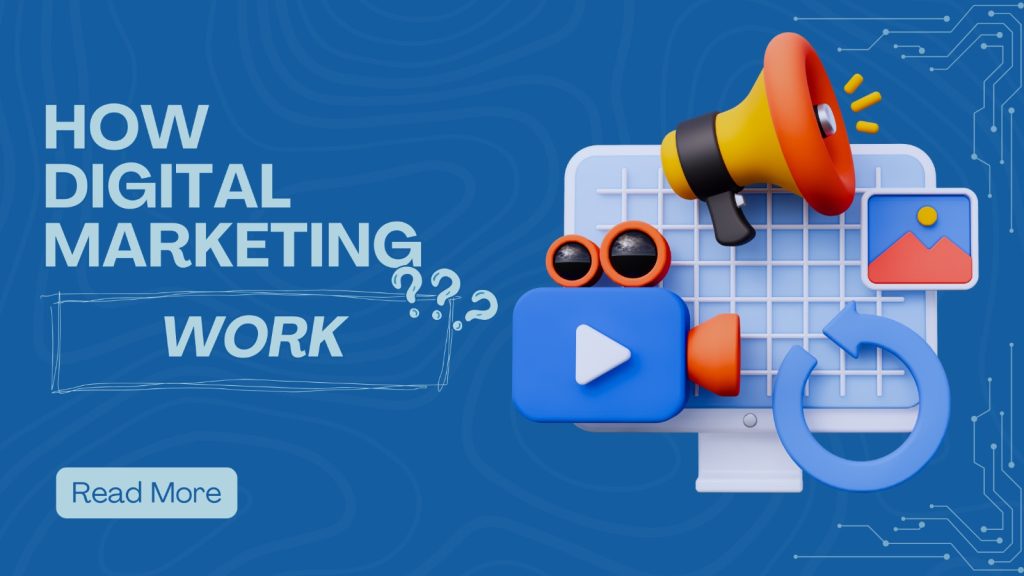
How Digital Marketing Works
The majority of what we do in the modern world has an online connection. Our lives are centered around digital platforms, whether we are shopping for clothes, booking tickets, getting information, or watching our favorite shows. And we all know what? In order to reach customers where they spend the majority of their time, businesses are now going online. Digital marketing can help with this.
At Digishinee, we think that digital marketing is about creating deep connections between businesses and consumers, not just about making sales. However, the real question is: how does digital marketing operate? Let’s dissect it in a straightforward, kind manner, step by step.
- Growing Aware of Digital Marketing Fundamentals Using digital channels such as websites, search engines, social media, email, and mobile apps for advertising goods or services is known as digital marketing. Digital marketing enables companies to target the correct audience, monitor outcomes in real time, and establish two-way contact, compared to traditional marketing methods like TV, newspapers, and billboards. Consider it this way: While everyone hears traditional marketing, not everyone is engaged. It’s like shouting through a loudspeaker in a crowded market. Talking directly to people who are already searching for what you have to offer is what digital marketing is all about.
- Digital Marketing’s Fundamental Elements A variety of platforms, strategies and tools make digital marketing effective. The primary pillars that support it are as follows: a) SEO, or search engine optimization You get thousands of results every time you type something into Google. Optimizing a website to rank highly in search engine results is known as SEO. SEO helps businesses become more visible, draw in customers, and establish trustworthiness. “If your business isn’t visible on Google, it’s almost invisible to your audience,” is a popular slogan at Digishinee.
c) Content Marketing
“The most important thing is content.” This statement is still relevant. Content includes things like instructional videos, blogs, and infographics. Instead of making a direct sale, content marketing informs, amuses, or motivates the audience.
A fitness company offering “10 Home Workouts,” for instance, is engaging in content marketing since it naturally draws customers and fosters trust.
b) Marketing on Social Media
People spend a lot of time on social media sites like YouTube, Facebook, Instagram, and LinkedIn. These platforms are used by businesses to interact, communicate, and tell their story. Social media is effective because it gives marketing a “human touch.”
It’s about community, innovation, and conversation, not simply advertisements.
d) PPC (Pay Per Click) Marketing
PPC is a type of paid advertising in which you only have to pay when an ad is clicked. The most well-known examples are Google Ads and Facebook Ads. It’s among the fastest ways to increase targeted traffic to your company.
f) Marketing through Email
Considering its ancient sound, email marketing is still one of the most effective strategies. It’s similar to having a direct connection to your client’s email. Businesses can foster relationships by sending out personalized emails with offers, advice, or updates.
g) Data and Analytics
Data is digital marketing’s secret sauce. Google Analytics is one tool that shows what is and is not working. Digital marketing, in contrast to conventional techniques, offers specific information on who clicked, how long they remained, and whether they made a purchase.
- The Digital Marketing Funnel
Digital marketing doesn’t work randomly. It follows a funnel-like process to turn strangers into loyal customers.
Awareness – People discover your brand through SEO, social media, or ads.
Interest – They start engaging with your content or exploring your website.
Consideration – They compare your products/services with competitors.
Conversion – They finally buy from you or sign up for your services.
Loyalty & Advocacy – With consistent value, they become repeat customers and even recommend you to others.
- Why Digital Marketing Works So Well
There are a few reasons why digital marketing is so powerful today:
Reach: You can connect with people across the globe or just in your local city.
Cost-Effective: Digital ads are cheaper than TV or print ads, and they reach more targeted audiences.
Personalization: Brands can send tailored messages that feel personal and relevant.
Measurable Results: Every click, like, and purchase can be tracked.
Engagement: Customers don’t just receive information—they interact with it.
- Real-Life Example of How Digital Marketing Works
Imagine you own a small bakery. Here’s how digital marketing can help you grow:
You create a website with SEO so that when someone searches “best bakery near me,” your bakery shows up.
You share mouth-watering cake photos on Instagram and interact with followers.
You run a Facebook ad targeting people within 5 km of your shop.
You start a blog about “healthy dessert recipes” to attract organic visitors.
You send emails to loyal customers with special offers like “Buy 1 Get 1 Free on Weekends.”
Within weeks, you’ll notice more footfall, more online orders, and stronger customer loyalty—all thanks to digital marketing.
- Future of Digital Marketing
The world of digital marketing is evolving rapidly. Artificial intelligence (AI), voice search, chatbots, influencer marketing, and video content are shaping the future. At Digishinee, we believe the next era of digital marketing will be about hyper-personalization—delivering the right message, to the right person, at the right time.
Conclusion
Digital marketing works because it blends creativity with technology, data with human connection. It’s not about just promoting—it’s about creating trust, delivering value, and building relationships.
For businesses, big or small, digital marketing opens the door to endless opportunities. At Digishinee, our mission is to make digital marketing simple, effective, and result-driven for everyone.
So the next time you wonder “how does digital marketing work?”—just remember: it works when strategy meets storytelling, and when businesses genuinely connect with their audience.
